Ralph Deutsch – The First Digital Organ |
Many of you may have read Jerome Markowitz’s account of this period of time in his online book “Triumphs and Trials of an Organ Builder.” My document is not a rebuttal, but rather my view of the same events. It is always good to have multiple views of history to help interpret the facts.
The new Rockwell/Allen partnership progressed smoothly at first. In fact, Allen seemed to be the perfect company to make the digital organ a true success.
Jerome (Jerry) Markowitz was the president of Allen. Mr. Markowitz had a great deal in common with my father, Ralph Deutsch. Both were Jewish and came from blue-collar families. Both decided not to carry on their family businesses because of greater interests – both in technology. Both had a fascination with the organ that started early in their childhood.
Mr. Markowitz invented the system used in the Allen Organs up until the digital organ. He had personally built his company from nothing into one of the most respected in the business. It was a small company but it had a great reputation for quality and authenticity.
To his credit, Mr. Markowitz was also the only person who was willing to take the risk with the new digital technology. He had the foresight to see the possibilities. This is one reason that Allen still exists today when nearly all the other companies that tried the Autonetics demonstrator organ are now gone.
Now that the organ deal was signed, it was time for my father to learn more about pipe organs. He joined the American Theater Organ Enthusiasts (ATOE) and he took my mother, sister, and I to their 1967 annual convention in Los Angeles. It was my first exposure to live theater organ music. We had some George Wright and Al Melgard records in the house, but this was the first time I could see how all of those effects were actually accomplished. In fact, I even got to hear George Wright in concert at the Los Angeles Elks Club during the convention. We also saw a real silent movie! It was Harold Lloyd in “Safety Last”. It was presented at the Wiltern Theater using the four-manual Kimball organ played by Gaylord Carter. There was a special surprise at the end when Gaylord introduced Harold Lloyd in the audience.
I attained Bar Mitzvah in 1968. One of my presents was a trip with my father to the East coast. He had two business stops, one at Allen and one at the US Patent Office in Washington DC. We traveled first to Chicago to attend the 1968 ATOE annual convention. I got to hear Al Melgard play the Chicago Stadium Barton organ.
We then flew to Philadelphia for the afternoon. By the time we had had lunch, he discovered he had set his watch an hour in the wrong direction! We had missed the afternoon Wanamaker organ concert! He took me to the Wanamaker store anyway and we asked how to get to the organ console. We were told to go to the second floor and good through the shoe department. After going through the back shoe storage rooms we found the console. We found a very young Keith Chapman, the head organist, putting his music away at the console. He let me sit at the console to be photographed. |
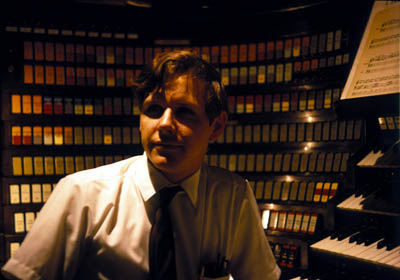
Keith Chapman at the Wanamaker Organ in 1968
|
We went back to the airport where we met Bob Pearce from Allen. He flew us to Allentown in the company airplane, a Beechcraft Queen. Just before landing, he let me take the controls for a couple turns.
We spent several days in Macungie, the real home of Allen Organ. I spent one of these at the Allen Organ Factory. I was given a tour and allowed to see the factory showroom – including many historic organs.
We also visited the Markowitz farm. Jerry Markowitz had a farm in addition to his home. I understood that this was one of his hobbies. It was a fully functioning farm with crops and cattle. He even insisted on being present to help when his cows were giving birth.
Steve Markowitz, Jerry’s son – and now the president of Allen – gave me the farm tour. He even took me fishing in the farm’s pond. To this day, it is the only time I have ever been fishing. |
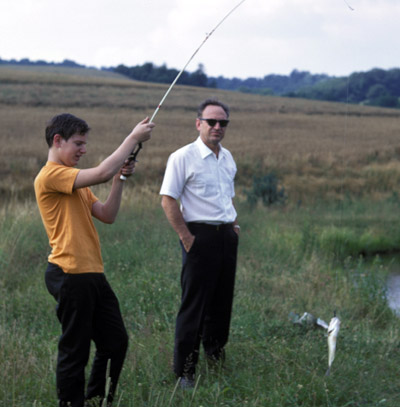
Les Deutsch with his “catch” next to Jerry Markowitz in 1968 |
My father then took me to Washington DC. This is when he showed me the still-existent WWII temporary buildings on the Mall. This was my first trip to Washington DC. I had no idea then that I would make at hundreds more trips to DC later in my life! On the last day of the trip, we departed from Dulles Airport. At the time, Dulles was viewed as the “airport to nowhere.” It was way out of town and no one used it. My father wanted me to see it because it might not exist much longer. He enjoyed showing me the operational concept for the airport – which, by the way, is no longer used. There was one large terminal building and the gates were very close to one another. They could be small because the airplanes did not park at the terminal. The airplanes parked on the tarmac and the passengers were moved between them in specially built shuttles. The shuttles looked like railroad coaches on monster truck chasses. They looked like railroad cars because the Budd Company, the same people who built most of the lightweight streamlined trains, built them. The chasses were required to adjust the height of the passenger compartment to match the varying height of the aircraft doors.
Mr. Markowtiz also gave me a bar mitzvah present in 1968. My father was working through him to purchase a new trumpet for me. He wanted me to have a real professional horn from Bach. Instead of brokering a deal for my father, Mr. Markowtiz simply purchased the trumpet and sent it to me as a present. It was a complete surprise. I used that trumpet until a year ago and it is still in fine condition.
Autonetics built an engineering model organ that was used to develop the final sounds for the first production instruments. It was built into a full size Allen organ console and could be played like a normal organ. However, since it did not yet have the custom microelectronics, there was a large cabinet to contain hundreds of digital logic boards. |
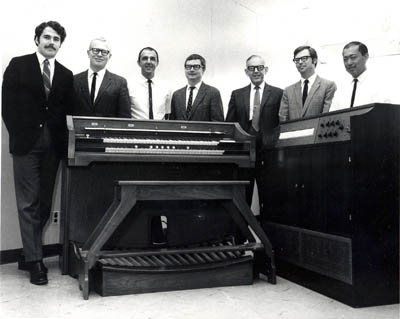 Autonetics team posing with the engineering model organ
Autonetics team posing with the engineering model organ |
Dr. Wright retired in 1968 (9?) so my father had to find me a new organ teacher. He selected Dr. Thomas Harmon who was the UCLA Organist and head of the Music Department. Dr. Harmon auditioned me and I was accepted. He was also retained as an expert on the Autonetics organ project. In addition, he held an outside position as organist at Santa Monica Methodist Church. This organ was sampled for the project and I believe that the Krumhorn stop that was on the first units came from this organ.
The Markowitz family came to visit Los Angeles the following year. In fact, they were all in our family home in Sherman Oaks on July 20, 1969. I know this because it was the night of the first human Moon landing. My parents had moved their large bedroom television set into the living room and set it on the fireplace. Our two families sat and watched Neil Armstrong make his famous first step onto the lunar surface. However, I am certain that the presence of a Rodgers organ in that living room angered Jerry. Rodgers was Allen’s main competitor.
Four prototype Allen Computer Organs were built about a year before the first model was released to the public. We had one in our house. One was kept at Autonetics. I think the other two went to Allen.
Our prototype was placed in the recreation room, next to the Conn theater organ. We now had three AGO organs in the house! It had a combination action with both general and divisional pistons and moving stop tabs. Unfortunately, there was no keep-alive power for the combination memory so I had to set it each time we turned on the organ. |
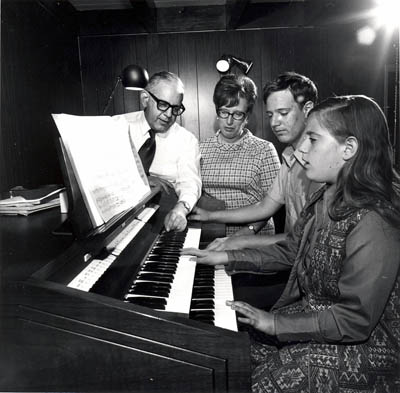
Allen prototype organ in the recreation room – notice the wood
paneling was unfinished, it is missing its crown molding
|
| This photo was part of a professional shoot that Rockwell commissioned in advance of the public release of the organ. In it, my parents, Barbara, and I gathered around the Allen prototype. This was not the photo that was used in the press releases. Instead, Rockwell chose the following photo, taken the same day. |
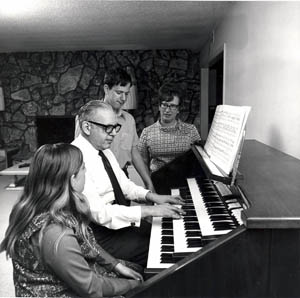 Deutsch family at the Rodgers 32B
Deutsch family at the Rodgers 32B |
This photo shows us standing around the Rodgers 32B! I suppose the room looked nicer and the lighting was better. In any case, I think this photo did not help relations between the Deutsches and the Markowitzes.
The prototype Allen had some very new features for the organ world. It had automatic transposition, meaning it could play in any key by simply turning a knob. It also had alterable voices. There were four stop tabs that could be “loaded” with waveshapes through the use of a card reader. My father had a library of several thousand cards from the organ development! These were sampled and processed from many pipe organs around the country. |
 Publicity photo of the card reader – shown using the engineering model organ
Publicity photo of the card reader – shown using the engineering model organ |
| There was a Rockwell board of directors meeting around that time. Since the organ was about to be released to the public with much publicity for Rockwell, my father arranged for one of the prototypes to be in the lobby of the Anaheim hotel where the meeting occurred. A driver was sent to our house to bring me to the hotel to play for the Directors before the meeting. I even met Colonel Rockwell himself. |
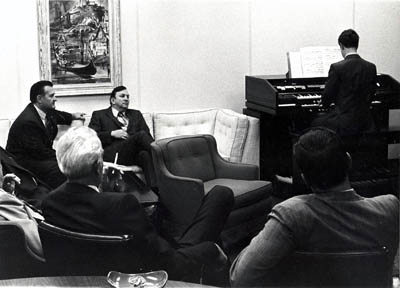 Les Deutsch demonstrating the Allen prototype organ
Les Deutsch demonstrating the Allen prototype organ
at a Rockwell board of directors meeting |
| The organ was introduced to the public in 1971 at a gala ceremony at the Waldorf Astoria Hotel in New York City. My father attended the ceremony but left the rest of us at home. |
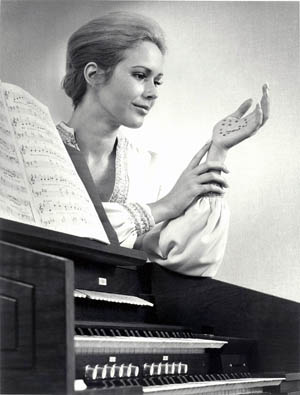 One of many photos prepared for the public release of the organ
One of many photos prepared for the public release of the organ |
It was a big success. It sounded so much better than any other electronic organ then on the market that there was almost no comparison. It won an award for best industrial development for that year.
However, it was not inexpensive. Nor were the larger models that followed.
There were also some quality problems at Rockwell. Some shipments of computer boards to Allen were late and it is possible some did not work properly. Rockwell, in turn, was upset with Allen because they were not making any progress putting the system into lower priced home organs. I also believe that Jerry Markowitz may have been upset personally because he was not the inventor of the digital system.
This is when the relationship fell apart. Allen sued Rockwell under U.S. antitrust laws. Rockwell sued back claiming a breach of contract. The lawsuit was long and dirty. My father and his boss were named as personal defendants in the Allen suit. The surprising thing was that they also named me at one point, though this was cleared up quickly after I submitted a deposition (I may have been the youngest U.S. citizen ever accused of industrial espionage.)
The lawsuits were eventually settled and Allen was given full rights to the patents. Despite all the personal troubles we had with the Markowitzes, the organ itself remains a very high quality (and very expensive) product. I have had occasion to play concerts on Allen organs from time to time and I have always enjoyed the experience.
Of course, once the Allen Computer Organ was released, the other organ companies saw that they had to upgrade their systems in order to compete. Many companies simply faded away. Others introduced digital systems of their own. Invariably, this resulted in a lawsuit from Allen – in most cases well deserved since it was hard to devise a system that did not infringe my father’s very broad patents. |
|

